The Turbulent Life of Nichiren: Trials, Tribulations, and the Truth of the Lotus Sutra in “Rissho Ankoku Ron” – Understanding the Power of “Nam-myoho-renge-kyo”
イントロダクション
日蓮の生涯は、法難と波乱に満ちたものでした。
彼が法華経とその教えを広める過程で遭遇した困難は、現代にも通じる強いメッセージを持っています。
『立正安国論』を通じて国の平和を訴え、題目の力を信じ抜いた日蓮。
彼の信念と行動は、多くの人々に影響を与え続けています。
この記事では、その波乱万丈の人生と、法華経の真実、そして題目の力に迫ります。
日蓮大聖人の生涯とその遺産
日蓮大聖人は、日本の鎌倉時代に活躍した仏教僧であり、日蓮宗(法華宗)の創始者として知られています。
彼の生涯は、厳しい試練と深い啓示に満ちており、その教えは今日に至るまで多くの人々に影響を与え続けています。
日蓮は、1222年に現在の千葉県に生まれました。
若い頃から仏教の学問に深い関心を寄せ、幾つかの宗派で学んだ後に、妙法蓮華経(法華経)の真理に至りました。
彼は、この経典を中心とした宗教運動を展開し、日蓮宗を創立しました。
『立正安国論』は、彼の代表的な著作であり、国家の安寧を願う内容が記されています。
日蓮は、この論文を通じて、当時の政治的混乱や自然災害が、人々の信仰の乱れに起因すると主張し、国主に諫暁しました。
しかし、この思想が当時の権力者の反感を買い、彼は佐渡に流罪となりました。
佐渡島での苦難の中、日蓮は清澄寺にて多くの重要な著作を書き残しました。
この時期には、『開目抄』や『報恩抄』など、彼の思想を集大成する作品が誕生しました。
佐渡流罪は、彼の精神的な成長にとって重要な転機となりました。
日蓮の教えは、妙法蓮華経の尊重と、南無妙法蓮華経の題目を唱えることに重点を置いています。
彼は、末法の時代において、この題目を唱えることが最も効果的な救済方法であると説きました。
また、念仏や他の宗教的実践を批判し、自らの信仰を「専修題目」と呼びました。
日蓮の生涯は、多くの法難に見舞われました。
松葉ヶ谷の法難、伊豆流罪、小松原の法難、龍の口の法難など、彼の教えを広める過程で、度重なる迫害に直面しました。
しかし、これらの試練を乗り越えたことで、彼の信念はさらに強固なものとなり、多くの信者を獲得することに成功しました。
日蓮は、1282年に身延山にて入滅しました。
彼の遺産は、多くの著作と、日蓮宗としての組織的な宗教運動によって継承されています。
日蓮の教えは、今日においても、その明確なメッセージと、個人の信仰に対する強い訴求力によって、多くの人々に受け入れられています。
Introduction
Nichiren’s life was filled with trials and turmoil.
The challenges he encountered while spreading the teachings of the Lotus Sutra carry a powerful message that resonates even in modern times.
Through his work “Rissho Ankoku Ron,” Nichiren advocated for national peace and steadfastly believed in the power of chanting the title of the Lotus Sutra.
His beliefs and actions continue to influence many people.
This article delves into his tumultuous life, the truths of the Lotus Sutra, and the power of chanting the title.
Life and Legacy of Nichiren Daishonin
Nichiren Daishonin was a Buddhist monk who thrived during Japan’s Kamakura period, renowned as the founder of Nichiren Buddhism (or the Lotus School).
His life was marked by profound trials and revelations, and his teachings have continued to impact countless individuals to this day.
Nichiren was born in 1222 in what is now Chiba Prefecture, Japan.
From a young age, he deeply immersed himself in Buddhist studies and eventually discovered the truths of the Lotus Sutra (Myoho-renge-kyo).
He pioneered a religious movement centered around this scripture and established Nichiren Buddhism.
“Rissho Ankoku Ron” stands as one of his seminal works, advocating for national peace amid political turmoil and natural disasters of his time.
Through this treatise, Nichiren argued that the unrest of the era stemmed from a decline in people’s faith, admonishing rulers to rectify the situation.
However, his ideas incurred the wrath of contemporary authorities, leading to his exile to Sado Island.
Amid the hardships on Sado Island, Nichiren wrote many crucial works at the Kiyosumi Temple.
During this period, works like “Kaimoku Sho” and “Hokke Gengi” crystallized his philosophical thoughts.
His exile became a pivotal juncture for his spiritual growth.
Nichiren’s teachings emphasize reverence for the Lotus Sutra and the chanting of “Nam-myoho-renge-kyo” as the most effective method of salvation in the Latter Day of the Law.
He critiqued practices like Nembutsu and other religious practices, advocating his own faith as “exclusive devotion to the Lotus Sutra.”
Nichiren faced numerous persecutions while spreading his teachings, such as the Matsubagayatsu Persecution, Izu Exile, Komatsubara Persecution, and Tatsunokuchi Persecution.
Despite these trials, his convictions grew stronger, ultimately gaining a significant number of followers.
Nichiren passed away in 1282 at Mount Minobu.
His legacy lives on through numerous writings and the organized religious movement of Nichiren Buddhism.
Nichiren’s teachings continue to resonate today, accepted by many for their clear message and compelling appeal to personal faith.
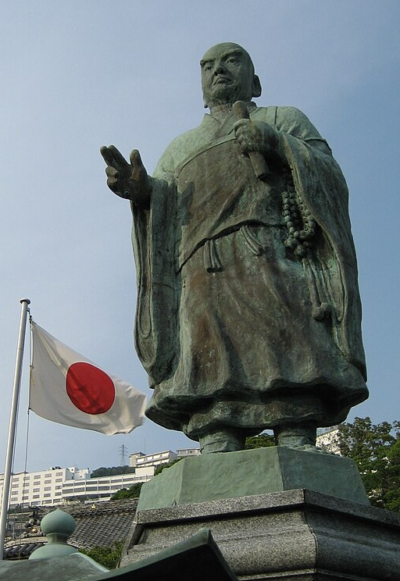
Portrait of Nichiren Shonin at Honrenji Temple, Nagasaki City
日蓮の生い立ちと日蓮宗(法華宗)の創立
日蓮大聖人は、日本の仏教宗派の一つ、日蓮宗の創始者として知られています。
彼の生涯は、困難に満ちながらも、強い信念と献身によって、多くの人々に影響を与えたものでした。
日蓮は1222年に生まれ、若くして仏教の深い学問に打ち込みました。
彼の思想の核心にあるのは、「妙法蓮華経」(法華経)への深い信仰であり、その教えを広めることに生涯を捧げました。
日蓮の教えは、『立正安国論』に最もよく表れています。
この著作では、国の平和と安定は、正しい仏法に基づく信仰に依存すると説いています。
日蓮は、自らの信念を広めるために、多くの試練に直面しました。
その中でも、佐渡流罪や伊豆流罪など、幾度もの迫害に遭いながらも、彼の強い信念は揺るぎませんでした。
日蓮宗の教えの中心にあるのは、「南無妙法蓮華経」という題目の唱えることです。
これは、法華経の教えを心の中に留め、日々の生活の中でそれを実践することを意味します。
日蓮は、この題目を唱えることで、人々が苦難を乗り越え、真の幸福を得られると信じていました。
彼の教えは、後に「専修題目」として知られるようになり、念仏や他の宗教的実践を批判しました。
日蓮の思想は、多くの文献にも記されており、『開目抄』や『観心本尊抄』などの著作は、彼の教えの深さを示しています。
日蓮の死後も、彼の教えは多くの人々に受け継がれ、日蓮宗として発展しました。
彼の教えが根付いた場所の一つに、清澄寺があります。この寺は、日蓮の教えを守り、伝え続ける重要な場所となっています。
日蓮大聖人の生涯と教えは、今日においても多くの人々に影響を与え続けています。
彼の信念と献身は、困難に直面しても決して諦めない強さの象徴とされています。
日蓮宗の教えを通して、人々は内なる平和と真の幸福を追求する道を見出しているのです。
『立正安国論』と国主諫暁:日蓮の思想と社会への影響
日蓮大聖人は、法華経の教えを根幹に、日蓮宗(法華宗)を創立した宗教家です。
彼の生涯は、幾多の試練と啓示に満ちていました。
特に、彼が著した『立正安国論』は、国主への諫暁を通じて、日本社会に深い影響を与えました。
この論文では、国家の安寧は正しい信仰に基づくべきだと主張しています。
日蓮は、佐渡島への流罪や清澄寺での厳しい生活を経験しましたが、これらの試練は彼の信仰をさらに深めることになります。
佐渡での生活は、彼の思想を磨き、後の著作活動に大きな影響を与えました。
妙法蓮華経、通称法華経は、日蓮の教えの中心であり、彼は「南無妙法蓮華経」という題目を専修し、これを唱えることで人々が救われると説きました。
また、末法の思想、すなわち現世が仏法が衰退する末法の時代にあるとの認識のもと、人々に法華経の信仰を勧めました。
日蓮は、念仏など他の宗教実践を批判し、法華経のみを専修することの重要性を説いたため、多くの法難に遭遇します。
松葉ヶ谷、伊豆、小松原、そして龍の口の法難は、彼の信仰と決意を試す重要な出来事でした。
彼の著作は多岐にわたり、『開目抄』や『報恩抄』など、後世の人々に大きな影響を与える文書を多数残しました。
これらの文書は、日蓮の思想をより深く理解する上で不可欠です。
身延山への入山や文永、弘安の役など、日蓮の生涯は、日本の歴史の中で重要な時期と重なります。
朝廷への諫暁や、最終的には入滅に至るまで、彼の生涯は、信仰と社会への影響を通じて、日本の宗教史において重要な役割を果たしました。
日蓮の思想と行動は、単に宗教的な枠組みを超えて、社会全体への深い影響を与えました。
『立正安国論』に象徴されるように、正しい信仰に基づく社会の安寧と繁栄を願う彼の思いは、今日においても多くの人々に共感を呼んでいます。
The Early Life of Nichiren and the Founding of Nichiren Buddhism (Hokke-shū)
Nichiren Daishonin is renowned as the founder of Nichiren Buddhism, one of Japan’s Buddhist sects.
His life, filled with adversity, was marked by unwavering conviction and dedication that profoundly impacted many.
Born in 1222, Nichiren immersed himself in Buddhist studies from a young age.
At the core of his philosophy was a deep faith in the Lotus Sutra (Hokkekyō), to which he devoted his life in spreading its teachings.
Nichiren’s teachings are best exemplified in his work “Risshō Ankoku Ron.”
In this writing, he argues that national peace and stability depend on correct faith in Buddhism.
To spread his beliefs, Nichiren faced numerous trials, including exile to Sado and Izu, yet his strong faith remained steadfast.
Central to Nichiren Buddhism is the chanting of the mantra “Nam Myōhō Renge Kyō.”
This entails embracing the teachings of the Lotus Sutra and practicing them daily.
Nichiren believed that chanting this mantra would help people overcome adversity and attain true happiness.
His teachings criticized practices like chanting other Buddhist mantras, advocating solely for the practice of the Lotus Sutra.
Nichiren’s philosophy, documented extensively in works like “Kaimoku-shō” and “Kanjin Honzon-shō,” illustrates the depth of his teachings.
Even after his passing in 1282, Nichiren’s teachings were perpetuated, fostering the development of Nichiren Buddhism.
One of the places where his teachings took root is at Minobu-san, where Nichiren’s legacy continues to be upheld and transmitted.
Nichiren Daishonin’s life and teachings continue to influence many today.
His unwavering faith and dedication symbolize resilience in the face of adversity.
Through Nichiren Buddhism, people find a path to inner peace and true happiness.
“Risshō Ankoku Ron” and His Advice to Rulers: Nichiren’s Philosophy and Its Impact on Society
Nichiren Daishonin, founder of Nichiren Buddhism (Hokke-shū), rooted in the teachings of the Lotus Sutra, was a religious leader.
His life was filled with many trials and revelations.
In particular, his work “Risshō Ankoku Ron” profoundly influenced Japanese society by advising rulers.
In this treatise, he argued that national peace should be based on correct faith.
Nichiren experienced exile to Sado Island and a harsh life at Minobu-san, experiences that deepened his beliefs.
His time on Sado refined his philosophy and greatly influenced his later literary activities.
The Lotus Sutra, also known as the Hokkekyō, formed the core of Nichiren’s teachings.
He preached that chanting “Nam Myōhō Renge Kyō” could save people and advocated for faith in the Lotus Sutra during the Latter Day of the Law.
Nichiren criticized practices like the Nembutsu and other religious practices, emphasizing the importance of exclusively practicing the Lotus Sutra.
Nichiren faced numerous persecutions during his efforts to spread his teachings, including the Matsubagayatsu Persecution, exile to Izu, Komatsubara Persecution, and the Dragon’s Mouth Persecution.
His writings spanned a wide range, including works like “Kaimoku-shō” and “Hōon-shō,” which had a significant impact on later generations.
These writings are essential for a deeper understanding of Nichiren’s philosophy.
Nichiren’s life coincided with critical periods in Japanese history, such as his entry to Minobu-san and the Bun’ei and Kōan campaigns.
From admonishing the imperial court to his eventual passing, his life played a significant role in Japanese religious history through faith and societal impact.
Nichiren’s thoughts and actions extended beyond religious frameworks, profoundly influencing society as a whole.
Symbolized in “Risshō Ankoku Ron,” his desire for peace and prosperity based on correct faith resonates deeply with many people today.
日蓮大聖人の『立正安国論』の内容
1. 日蓮大聖人とは
日本の仏教史において、日蓮大聖人は極めて重要な人物です。
彼は宗教改革者として知られ、仏教の教えをより広く、より深く理解しようとしました。
その中で、彼の代表的な著作の一つである『立正安国論』は、彼の思想や見解が凝縮された貴重な文化財です。
2. 『立正安国論』の背景とは
『立正安国論』は、日蓮大聖人が鎌倉時代に書かれた重要な著作です。
この論文は、当時の政治情勢や社会情勢の中で、仏教が果たすべき役割や、国家の安定と繁栄のための仏教の教えについて論じています。
日蓮大聖人は、仏教の教えを通じて国家の安定と人々の幸福を追求することを提唱しました。
3. 立正安国の理念
『立正安国論』の中心にある理念は、”立”(正しい教えを立てる)、”正”(正しい法を行う)、”安”(国家の安定を実現する)、”国”(国家全体)という四つの要素です。
日蓮大聖人は、これらの要素が結びつくことで、国家の安定と繁栄が実現できると考えました。
彼の見解では、仏教の教えが政治の礎となり、国家の治安と社会の調和を確保するための重要な手段として機能するという点が重要です。
4. 仏教の普遍性と国家の役割
『立正安国論』では、仏教の普遍的な教えが特定の国や地域だけでなく、あらゆる社会や文化に適用可能であることが強調されています。
日蓮大聖人は、仏教の教えが国家の指導者や一般市民によって理解され、実践されることで、社会全体の幸福と繁栄がもたらされると信じていました。
彼の見解では、仏教は単なる宗教だけでなく、国家の中核として機能し、国家の安定と発展に寄与する可能性を秘めているとされています。
5. まとめ
『立正安国論』は、日蓮大聖人の仏教観や政治観が凝縮された貴重な著作です。
彼は仏教の普遍性とその社会的役割を強調し、国家の安定と繁栄を実現するための道を示唆しました。
そのため、今日の日本社会や世界の政治においても、『立正安国論』の見解や理念は重要であり、深く考える価値があります。
Contents of Nichiren Daishonin’s “Rissho Ankoku Ron”
- Who is Nichiren Daishonin?
In Japanese Buddhist history, Nichiren Daishonin is an immensely significant figure.
Known as a religious reformer, he sought to deepen and broaden the understanding of Buddhist teachings.
Among his notable works, “Rissho Ankoku Ron” stands as a valuable cultural asset encapsulating his thoughts and views.
- Background of “Rissho Ankoku Ron”
“Rissho Ankoku Ron” is an important work written by Nichiren Daishonin during the Kamakura period.
This treatise discusses the role Buddhism should play amidst the political and social conditions of that time, advocating for Buddhist teachings that contribute to the stability and prosperity of the nation.
Nichiren Daishonin advocated for pursuing national stability and people’s happiness through Buddhist teachings.
- Ideals of Establishing Righteousness and Ensuring Peace of the Nation
The central theme of “Rissho Ankoku Ron” revolves around four elements: “Rissho” (establishing correct teachings), “Sei” (practicing correct laws), “An” (realizing national stability), and “Koku” (the entire nation).
Nichiren Daishonin believed that by integrating these elements, national stability and prosperity could be achieved.
In his view, Buddhist teachings serve as a cornerstone for politics, ensuring public safety and societal harmony.
- Universality of Buddhism and the Role of the State
“Rissho Ankoku Ron” emphasizes the universal nature of Buddhist teachings, applicable not only to specific countries or regions but to all societies and cultures.
Nichiren Daishonin believed that when Buddhist teachings are understood and practiced by leaders and citizens alike, they bring about happiness and prosperity to society as a whole.
His perspective underscores that Buddhism functions not merely as a religion but as a core element within the state, contributing to its stability and development.
- Conclusion
“Rissho Ankoku Ron” is a precious work that encapsulates Nichiren Daishonin’s views on Buddhism and politics.
He emphasized the universality of Buddhism and its societal role, suggesting pathways to achieve national stability and prosperity.
Therefore, in today’s Japanese society and global politics, the insights and ideals presented in “Rissho Ankoku Ron” remain crucial and worthy of deep contemplation.
佐渡流罪と清澄寺:試練と啓示の地
日蓮大聖人は、日本仏教史において重要な位置を占める人物です。
彼の生涯は、困難と啓示に満ちたものでした。
日蓮宗の創立者として、彼は妙法蓮華経を中心とした教義を広め、多くの人々に影響を与えました。
日蓮の生い立ちは、彼が後に展開する活動の基盤となります。
若き日の日蓮は、仏教の深い学問に触れ、特に妙法蓮華経に強い帰依を示しました。
この経典を通じて、彼は末法思想と「南無妙法蓮華経」の専修題目を強調しました。
『立正安国論』は、日蓮の思想の集大成とも言える作品です。
この論文を通じて、彼は国の危機を救うためには仏法に基づく国政が必要であると主張し、国主への諫暁を行いました。
その思想は、社会に大きな影響を与え、多くの追随者を生み出しました。
佐渡流罪は、日蓮の生涯における重要な試練の一つでした。
この時期に彼は、清澄寺での修行と瞑想を通じて、さらなる啓示を受けました。
佐渡での苦難は、日蓮の信念をより一層強固なものにし、彼の教えの深化に寄与しました。
妙法蓮華経は、日蓮宗の中心となる経典です。
日蓮は、この経典が末法の時代における唯一の救済の道であると説きました。
彼の教えは、「南無妙法蓮華経」という題目の唱えることによって、人々が苦難を乗り越え、悟りに至ることができると主張しています。
日蓮大聖人の生涯とその遺産は、今日においても多くの人々に影響を与え続けています。
彼の教えは、困難に直面した時に希望を見出し、自己の信念を貫く勇気を与えてくれます。
佐渡流罪と清澄寺での試練は、日蓮が遺した多くの教えの中でも特に心に残るエピソードです。
Exile to Sado Island and Kiyosumi Temple: Land of Trials and Revelations
Nichiren Daishonin holds a significant place in Japanese Buddhist history.
His life was marked by challenges and profound revelations.
As the founder of Nichiren Buddhism, he spread the teachings centered around the Lotus Sutra, influencing many.
Nichiren’s upbringing laid the groundwork for his later activities.
In his youth, Nichiren delved deep into Buddhist studies, particularly showing strong devotion to the Lotus Sutra.
Through this scripture, he emphasized the concept of the Latter Day of the Law and the exclusive practice of “Nam Myoho Renge Kyo.”
“Rissho Ankoku Ron” can be seen as the culmination of Nichiren’s thoughts.
Through this treatise, he argued that governance based on Buddhist principles was necessary to save the nation from crisis, advising rulers accordingly.
His ideas had a profound impact on society, generating numerous followers.
Exile to Sado Island was a significant trial in Nichiren’s life.
During this period, he underwent further revelations through ascetic practices and meditation at Kiyosumi Temple.
The hardships on Sado Island strengthened Nichiren’s beliefs and contributed to the deepening of his teachings.
The Lotus Sutra is central to Nichiren Buddhism.
Nichiren proclaimed this scripture as the sole path to salvation in the Latter Day of the Law.
His teachings assert that chanting “Nam Myoho Renge Kyo” enables people to overcome suffering and attain enlightenment.
Nichiren Daishonin’s life and legacy continue to influence many today.
His teachings provide hope and courage to persevere in times of adversity.
The exile to Sado Island and the trials at Kiyosumi Temple remain particularly poignant episodes among Nichiren’s enduring lessons.
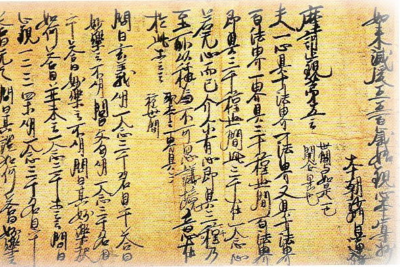
“5500 Years After the Buddha’s Death, the Beginning of Contemplation of the Honzon”
“Introduction to ‘Keanjin Honzon-sho’: Written by Nichiren, Housed at Hokkekyo-ji Temple, a National Treasure”
(巻頭部分、日蓮撰・筆、法華経寺蔵、国宝)
日蓮大聖人の『如来滅後五五百歳始観心本尊抄』の内容
1. 日蓮大聖人の業績とは
日蓮大聖人は、日本仏教史上で最も重要な人物の一人です。
彼は、宗教改革者として知られ、自らの教えを確立し、多くの著作を残しました。
その中でも『如来滅後五五百歳始観心本尊抄』は、彼の思想や教義が凝縮された重要な著作です。
2. 『如来滅後五五百歳始観心本尊抄』とは
この著作は、日蓮大聖人が1253年に書かれたもので、日本仏教の宗教的理論に関するものです。
『如来滅後五五百歳始観心本尊抄』は、仏教の教えに基づいて、如来(仏)の到来や世界の終焉についての考察を行っています。
3. 如来滅後五五百歳始観とは
日蓮大聖人は、仏教の経典や教義を解釈し、如来滅後五五百歳始観という概念を提唱しました。
これは、仏陀の涅槃(死後の解脱)から2550年後に、世界が終末を迎えるという考え方です。
彼は、この期間が現在の時代であり、信仰と修行によって自己の救済を図ることが重要であると説きました。
4. 心本尊とは
『如来滅後五五百歳始観心本尊抄』では、心本尊という概念も重要に扱われています。
これは、心が如来そのものであり、心の清浄さが仏に到達するための道であるという考え方です。
日蓮大聖人は、心本尊の信仰と実践が、人々の救済と世界の平和につながると説きました。
5. まとめ
『如来滅後五五百歳始観心本尊抄』は、日蓮大聖人の仏教観や宗教的理論が凝縮された重要な著作です。
彼の思想は、如来滅後五五百歳始観や心本尊という概念を通じて、救済と平和の道を示唆しています。
この著作は、日本仏教の歴史や信仰の理解を深めるうえで、重要な一端を担っています。
“The Contents of Nichiren Daishonin’s ‘Kenjin Honzon-sho'”
- Nichiren Daishonin’s Contributions
Nichiren Daishonin is one of the most significant figures in Japanese Buddhist history.
He is renowned as a religious reformer who established his own teachings and left behind numerous writings.
Among these, ‘Kenjin Honzon-sho’ stands out as a pivotal work encapsulating his thoughts and doctrines.
- What is ‘Kenjin Honzon-sho’?
Written by Nichiren Daishonin in 1253, this work delves into the religious theories of Japanese Buddhism.
‘Kenjin Honzon-sho’ explores the arrival of the Tathagata (Buddha) and the end of the world based on Buddhist teachings.
- The Concept of Kenjin (2550 Years After the Buddha’s Parinirvana)
Nichiren Daishonin interpreted Buddhist scriptures and proposed the concept of ‘Kenjin’—suggesting that 2550 years after the Buddha’s parinirvana, the world would reach its end.
He argued that this period is the current age, emphasizing the importance of personal salvation through faith and practice.
- What is Honzon?
In ‘Kenjin Honzon-sho’, the concept of ‘Honzon’ (object of devotion) is also crucially discussed.
It posits that the mind itself is the Honzon, and the purity of one’s mind leads to attaining Buddhahood.
Nichiren Daishonin asserted that faith and practice centered on Honzon lead to the salvation of individuals and contribute to world peace.
- Conclusion
‘Kenjin Honzon-sho’ is a significant work where Nichiren Daishonin’s Buddhist views and religious theories are condensed.
Through concepts like Kenjin and Honzon, his teachings suggest paths to salvation and peace.
This work plays a vital role in deepening our understanding of the history and faith of Japanese Buddhism.
妙法蓮華経(法華経)と末法思想:南無妙法蓮華経の力
日蓮大聖人は、日本の鎌倉時代に活躍した仏教僧であり、日蓮宗(法華宗)の創立者として知られています。
彼の生涯は、厳しい試練と深い啓示に満ちていました。
1222年に誕生した日蓮は、若くして仏教の真理を求める旅に出ました。
その結果、妙法蓮華経(法華経)を最高の教えとし、その普及に生涯を捧げることになります。
日蓮は、国内の混乱と外国からの脅威を憂い、『立正安国論』を著し、国主に対して国家の安泰を願う諫暁を行いました。
しかし、その強い信念と行動は、多くの人々からの反発を招き、彼は幾度となく迫害に遭います。
中でも、佐渡流罪や清澄寺での過酷な生活は、彼の信念をさらに深めることとなりました。
日蓮の教えの中心は、妙法蓮華経への深い信仰でした。
彼は、末法の時代においても、南無妙法蓮華経を唱えることで、人々が苦難を乗り越え、真の幸福を得ることができると説きました。
この「専修題目」の実践は、日蓮宗の信者にとって最も重要な修行となっています。
日蓮の思想は、多くの著作によって後世に伝えられています。
『開目抄』『観心本尊抄』『守護国家論』など、彼の作品は、仏法解釈の新たな地平を開きました。
また、日蓮は、伊豆流罪や松葉ヶ谷の法難など、生涯にわたって多くの試練に直面しましたが、これらの困難を乗り越えることで、彼の教えはさらに深まり、広まっていきました。
日蓮大聖人の入滅後も、彼の教えは多くの人々に受け継がれ、今日に至るまで、その影響力は衰えることがありません。
日蓮が示した、妙法蓮華経への絶対的な信仰と、それに基づく生き方は、現代においても多くの人々にとって大きな指針となっています。
日蓮大聖人の生涯と教えは、末法思想を超え、普遍的な真理の追求という、人類共通のテーマに光を当てています。
“The Lotus Sutra and the End-Times Thought: The Power of Nam-myoho-renge-kyo”
Nichiren Daishonin, a Buddhist monk who thrived during Japan’s Kamakura period, is celebrated as the founder of Nichiren Buddhism (Hokke-shu).
His life was marked by severe trials and profound revelations.
Born in 1222, Nichiren embarked on a quest for Buddhist truths at a young age.
As a result, he embraced the Lotus Sutra (Hokke-kyo) as the ultimate teaching and dedicated his life to its propagation.
Concerned about domestic turmoil and foreign threats, Nichiren authored “Rissho Ankoku Ron,” advising rulers on ensuring national security.
However, his strong beliefs and actions provoked resistance and persecution.
Notably, his exile to Sado Island and harsh life at Seicho-ji deepened his convictions.
Central to Nichiren’s teachings was deep faith in the Lotus Sutra.
He proclaimed that even in the Latter Day of the Law, chanting Nam-myoho-renge-kyo enables people to overcome suffering and attain true happiness.
Practicing this “Daimoku” became the paramount discipline for Nichiren Buddhists.
Nichiren’s thoughts were transmitted through numerous writings.
Works like “Kaimoku-sho,” “Kanjin Honzon-sho,” and “Shugo Kokka Ron” expanded interpretations of Buddhist doctrines.
Throughout his life, Nichiren faced trials such as exile to Izu and persecution at Matsubagayatsu, each ordeal deepening and spreading his teachings.
Even after Nichiren Daishonin’s passing, his teachings were upheld by many, and their influence remains undiminished today.
Nichiren’s absolute faith in the Lotus Sutra and the way of life it inspired serve as significant guiding principles for many even in modern times.
His life and teachings transcend the concept of the Latter Day of the Law, shedding light on the pursuit of universal truths, a theme essential to humanity.
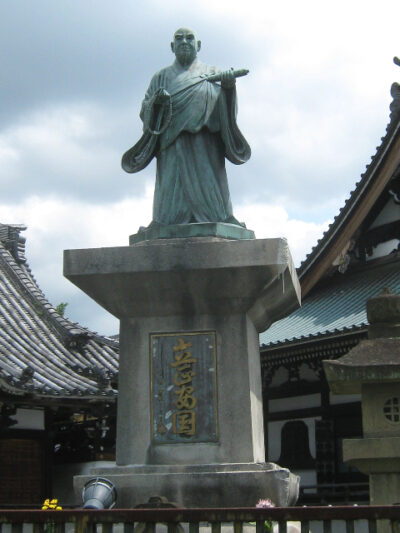
Image of Nichiren Shonin at Myoden-ji Temple, Sakyo-ku, Kyoto
日蓮の教義とその実践
日蓮大聖人は、日蓮宗(法華宗)の宗祖として知られ、その教えは今日でも多くの人々に影響を与え続けている。
彼の教義の中心にあるのは、「専修題目」としての南無妙法蓮華経の唱題である。
この実践を通じて、日蓮は人々が末法の時代においても真の幸福を見出すことができると説いた。
念仏など他の宗教実践を批判し、妙法蓮華経(法華経)のみを唯一の救済の道と位置づけたのである。
日蓮の生涯は、法難と呼ばれる様々な迫害に満ちていた。
松葉ヶ谷、伊豆、小松原、龍の口といった場所での法難は、彼の信念の強さを示すエピソードとして語り継がれている。
特に、龍の口の法難では、日蓮の命が危ぶまれたが、彼は不動の信念でこれを乗り越えた。
日蓮は、『立正安国論』や『開目抄』など多数の著作を残しており、これらは彼の教えの核心を伝える重要な文献である。
『一代聖教大意』から『開目抄』に至るまで、日蓮の著作は、妙法蓮華経を中心とした仏法理解の深化を促すものであった。
また、『一念三千理事』や『一念三千法門』を通じて、日蓮は仏法の深遠な理論を展開し、信者たちが日常生活の中でこの教えを実践する方法を指南した。
日蓮の教義は、信仰の実践を通じて個人の内面を豊かにし、社会全体の平和を実現することを目指している。
彼の生涯と教えは、現代においても多くの人々に勇気と希望を与え、心の平安を見出すための指針となっている。
日蓮大聖人の教えを深く理解し、その実践に励むことは、今日の社会においても非常に意義深いことであると言えるだろう。
「専修題目」の意義と念仏批判
日蓮大聖人は、日蓮宗(法華宗)の宗祖として知られ、その教えは妙法蓮華経(法華経)に基づくものである。
彼の教義の核心にあるのが「専修題目」という概念であり、これは南無妙法蓮華経を唱えることによって、末法の世における救済を目指すものである。
日蓮は、この「専修題目」を通じて、当時盛んであった念仏宗等の他宗教批判を展開し、その教えの正しさを強調した。
日蓮の生涯は、その教えを広める過程で数々の法難に遭遇することとなった。
松葉ヶ谷、伊豆、小松原、龍の口といった地での法難は、彼の信念の固さを示すとともに、その教えがいかに当時の社会に衝撃を与えたかを物語っている。
特に、龍の口の法難は、日蓮の教義が広く知られるきっかけとなった出来事である。
日蓮は、その思想を多くの著作に残している。
『立正安国論』では国家の安寧を願い、国主に諫暁を行っている。
また、『一代聖教大意』から『開目抄』に至るまでの著作では、日蓮の深遠な仏法理解が示されており、『一念三千理事』や『一念三千法門』といった教義は、日蓮仏法の核心をなす。
日蓮の教えは、彼の入滅後も多くの人々によって引き継がれ、今日に至るまでその影響力は衰えることがない。
清澄寺や身延山久遠寺など、彼が遺した地は信者たちにとって聖地とされ、彼の教えを今に伝える場となっている。
日蓮大聖人の生きた時代背景、彼が直面した困難、そしてその教えが今日の我々にどのような意味を持つのかを考えることは、現代社会においても重要な意義を持つ。
彼の教えは、単なる宗教的信念を超え、人々が直面する苦悩に対する一つの答えを提供しているのである。
法難の連続:松葉ヶ谷、伊豆、小松原、龍の口
日蓮大聖人は、日蓮宗(法華宗)の宗祖として知られ、彼の教えは『妙法蓮華経』(法華経)に基づいています。
その中心思想「専修題目」は、南無妙法蓮華経と唱えることで、末法の世においても人々が救われるというものです。
日蓮は、念仏など他宗教の教えを批判し、これが多くの法難を引き起こしました。
松葉ヶ谷の法難、伊豆流罪、小松原の法難、龍の口の法難という四つの大きな試練は、日蓮の信念とその強固な実践を示す出来事でした。
これらの法難を通じて、彼は『立正安国論』をはじめとする多くの著作を残し、後世に大きな影響を与えました。
『一代聖教大意』から『開目抄』に至るまで、日蓮の著作は、彼の深遠な仏法理解を示しています。
特に『一念三千理事』と『一念三千法門』は、日蓮教義の核心をなす教えであり、仏法の深い真理を解き明かしています。
日蓮の生涯は、佐渡流罪や身延入山など、数々の困難に満ちていましたが、彼は常に妙法蓮華経を唱え、末法の世を生きる人々のために、仏法の普及に尽力しました。
清澄寺や他の寺院での布教活動、朝廷や国主への諫暁など、彼の行動は、後世の日蓮宗の発展に大きな礎を築きました。
日蓮大聖人の教えは、今日でも多くの人々に影響を与え続けており、彼の信念とその実践の歴史は、仏教徒だけでなく、多くの人々にとって大きな教訓となっています。
日蓮の生涯と著作を通じて、我々は末法の世を生き抜く智慧と勇気を学ぶことができるのです。
Nichiren’s Teachings and Their Practice
Nichiren Daishonin is renowned as the founder of Nichiren Buddhism (Hokke-shu) and his teachings continue to influence many today.
Central to his doctrine is the practice of chanting Nam-myoho-renge-kyo, known as the “Daimoku.” Through this practice, Nichiren preached that individuals could find true happiness even in the Latter Day of the Law.
He criticized practices such as Nembutsu and emphasized the Lotus Sutra (Myoho-renge-kyo) as the sole path to salvation.
Nichiren’s life was fraught with persecution known as “ho-nan,” or severe trials. Episodes like those in Matsubagayatsu, Izu, Komatsubara, and Tatsunokuchi are tales of his unwavering faith.
Particularly, the Tatsunokuchi incident endangered Nichiren’s life, but he overcame it with unshakable conviction.
Nichiren left numerous writings such as “Rissho Ankoku Ron” and “Kaimoku-sho,” which elucidate the core of his teachings.
From “Kanjin no Honzon-sho” to “Kaimoku-sho,” Nichiren’s writings deepen understanding of Buddhist principles centered around the Lotus Sutra.
Through works like “Ichinen Sanzen Rissho” and “Ichinen Sanzen Homon,” Nichiren elaborated profound Buddhist theories and instructed followers on integrating these teachings into daily life.
Nichiren’s doctrine aims not only to enrich individual spirituality through faith but also to achieve societal peace.
His life and teachings continue to inspire courage, hope, and inner peace among many today.
Understanding Nichiren Daishonin’s teachings deeply and striving to practice them remain profoundly significant in contemporary society.
Significance of “Daimoku” and Criticism of Nembutsu
Nichiren Daishonin, the founder of Nichiren Buddhism (Hokke-shu), based his teachings on the Lotus Sutra (Myoho-renge-kyo).
Central to his doctrine is the concept of “Daimoku,” or chanting Nam-myoho-renge-kyo, which aims for salvation in the Latter Day of the Law.
Through “Daimoku,” Nichiren critiqued prevalent practices such as Nembutsu in other religious sects and emphasized the correctness of his teachings.
During his lifetime, Nichiren faced numerous persecutions in his efforts to spread his teachings.
Trials such as those in Matsubagayatsu, Izu Exile, Komatsubara, and Tatsunokuchi are examples of challenges that highlighted Nichiren’s unyielding faith and the impact of his teachings on society at that time.
In particular, the Tatsunokuchi incident marked a pivotal moment in the spread of Nichiren’s teachings.
Nichiren left behind a vast array of writings.
In “Rissho Ankoku Ron,” he advocated for the peace and security of the nation and admonished the government leaders.
From “Kanjin no Honzon-sho” to “Kaimoku-sho,” his writings illustrate profound understandings of Buddhist principles, and teachings such as “Ichinen Sanzen Rissho” and “Ichinen Sanzen Homon” form the core of Nichiren Buddhism.
Even after his passing, Nichiren’s teachings were continued by many, and his influence remains undiminished to this day.
Places like Myoden-ji Temple and Mount Minobu, which he left behind, are considered sacred by believers and continue to transmit his teachings.
Reflecting on Nichiren Daishonin’s historical context, the challenges he faced, and the relevance of his teachings to us today are of great importance in contemporary society.
His teachings provide answers to the sufferings people face, extending beyond mere religious beliefs.
日蓮の著作とその教え『一代聖教大意』から『開目抄』まで
日蓮大聖人は、日蓮宗(法華宗)の宗祖として知られ、その教えは妙法蓮華経(法華経)に基づくものである。
彼の思想の核心には、「専修題目」の実践がある。
これは、「南無妙法蓮華経」と唱えることにより、末法の世を生きる人々が悟りを開く道を示したものだ。
日蓮は、念仏など他の宗教的実践を批判し、法華経の題目を唱えることの重要性を説いた。
日蓮の生涯は、法難と呼ばれる試練に満ちていた。
松葉ヶ谷、伊豆、小松原、龍の口での法難は、彼の信念の強さを示すものであり、彼はこれらの困難を乗り越えて法華経の教えを広めた。
特に、龍の口の法難は、日蓮の信仰と決意の象徴とされている。
日蓮は、『一代聖教大意』から『開目抄』まで、多くの著作を残した。
これらの文書は、日蓮の教義を深く理解するための鍵となる。
『一念三千理事』と『一念三千法門』は、仏法の深遠な理解を示す文書であり、日蓮の思想の核をなす。
これらのテキストを通じて、日蓮は妙法蓮華経の真髄を明らかにし、信者たちに末法の時代における正しい実践の道を指し示した。
日蓮の教えは、『立正安国論』においても顕著である。
この中で彼は、国家の平和と安定は、正しい信仰と実践に依存すると説いた。
日蓮は、国主や朝廷への諫暁を通じて、社会の改革を求めた。
彼のこのような行動は、佐渡流罪や伊豆流罪へと繋がり、その後も清澄寺や身延入山での生活を余儀なくされた。
日蓮大聖人の入滅後も、彼の教えは多くの人々に影響を与え続けている。
『撰時抄』や『報恩抄』などの文書は、日蓮の思想を後世に伝えるための重要な資料となっている。
日蓮の生涯と教えは、法華経の普遍的なメッセージを現代に伝えるための貴重な手段であり、彼の信念と実践は今日も多くの人々にとって大きな意味を持っている。
『一念三千理事』と『一念三千法門』:深遠な仏法理解
日蓮大聖人は、日蓮宗(法華宗)の宗祖として知られ、その教えは多くの著作によって後世に伝えられています。
特に、『立正安国論』をはじめ、『一代聖教大意』や『開目抄』などの文献は、彼の思想の核心をなすものです。
日蓮大聖人は、妙法蓮華経(法華経)を尊ぶことを通じて、末法の時代における仏法の真髄を明らかにしました。
「専修題目」とは、南無妙法蓮華経を唱える実践を指し、これによって他の念仏などの修行法を批判しました。
日蓮大聖人は、この題目を唱えることが、末法の時代において最も適切な修行法であると主張しました。
日蓮大聖人の生涯は、法難に満ちていました。
松葉ヶ谷、伊豆、小松原、龍の口など、数々の法難を乗り越え、その信念を守り抜きました。
これらの試練は、彼の教えの真価を高め、多くの人々にその教義が広まるきっかけとなりました。
『一念三千理事』と『一念三千法門』は、日蓮大聖人の教えの中でも特に深遠な仏法理解を示す概念です。
これらは、一念の中に三千の世界が存在するという教義を説明しており、日蓮大聖人の宇宙観や人間観を深く反映しています。
彼は、この理解を通じて、人々が自身の内にある仏性に目覚め、苦しみを乗り越える力を得ることができると説きました。
日蓮大聖人の著作は、その後の日蓮宗の発展に大きな影響を与えました。
『唱法華題目抄』や『守護国家論』などの文献は、国家や社会に対する彼の洞察を示しており、『災難対治抄』や『種種御振舞御書』では、人々が直面する困難に対する具体的な指針を提供しています。
日蓮大聖人は、身延山に入山し、その地で多くの弟子を育成しました。
文永の役や弘安の役のような歴史的な出来事の中で、彼は常に朝廷や国主への諫暁を行い、仏法の守護と国家の平和を訴え続けました。
その生涯は、入滅するまで仏法への深い信仰と実践によって彩られていました。
日蓮大聖人の教えは、今日においても多くの人々に影響を与え続けています。
『一念三千理事』と『一念三千法門』をはじめとする彼の深遠な仏法理解は、現代社会における精神的な指針となっています。
Nichiren’s Writings and Teachings: From “Kanjin no Honzon-sho” to “Kaimoku-sho”
Nichiren Daishonin is renowned as the founder of Nichiren Buddhism (Hokke-shu), grounded in the Lotus Sutra (Myoho-renge-kyo).
At the core of his philosophy lies the practice of “Daimoku,” chanting “Nam-myoho-renge-kyo,” which he presented as the path for people to attain enlightenment in the Latter Day of the Law.
Nichiren criticized practices like Nembutsu, emphasizing the importance of chanting the Lotus Sutra’s title.
His life was filled with trials known as “ho-nan” or persecutions. Challenges in places like Matsubagayatsu, Izu, Komatsubara, and Tatsunokuchi demonstrated his steadfast faith and efforts to spread the teachings of the Lotus Sutra.
The Tatsunokuchi incident particularly symbolizes Nichiren’s faith and determination.
Nichiren left behind numerous writings from “Kanjin no Honzon-sho” to “Kaimoku-sho,” pivotal texts for understanding his doctrine.
Works like “Ichinen Sanzen Rissho” and “Ichinen Sanzen Homon” elucidate profound Buddhist insights, forming the essence of Nichiren’s teachings.
Through these texts, Nichiren clarified the essence of the Lotus Sutra and guided believers on the correct practice for the Latter Day of the Law.
Nichiren’s teachings are notably expressed in “Rissho Ankoku Ron,” where he argued that national peace and stability depend on correct faith and practice.
Through admonitions to rulers and the court, Nichiren sought societal reform, leading to his exiles in Sado and Izu, followed by a life at Mount Minobu’s Minobusan Kuon-ji.
Even after Nichiren Daishonin’s passing, his teachings continued to influence many.
Documents like “Senji-sho” and “Hokke Mongu” serve as crucial resources for transmitting Nichiren’s thoughts to future generations.
Nichiren’s life and teachings serve as invaluable means for conveying the universal message of the Lotus Sutra to contemporary times, offering profound significance to many in their faith and practice.
“Ichinen Sanzen Rissho” and “Ichinen Sanzen Homon”: Profound Understanding of Buddhist Doctrine
Nichiren Daishonin, revered as the founder of Nichiren Buddhism (Hokke-shu), conveyed his teachings through numerous writings that have been passed down through the ages.
In particular, texts such as “Rissho Ankoku Ron,” “Kanjin no Honzon-sho,” and “Kaimoku-sho” encapsulate the essence of his philosophy.
Nichiren Daishonin illuminated the essence of the Lotus Sutra (Myoho-renge-kyo) by venerating it, asserting that chanting “Nam-myoho-renge-kyo” represents the most appropriate practice in the Latter Day of the Law.
The concept of “Daimoku” focuses on the practice of chanting Nam-myoho-renge-kyo, criticizing other religious practices like Nembutsu.
Throughout his life, Nichiren Daishonin faced numerous persecutions. Overcoming challenges in locations such as Matsubagayatsu, Izu, Komatsubara, and Tatsunokuchi, he maintained his faith and persevered to spread the teachings of the Lotus Sutra.
These trials enhanced the credibility of his teachings and prompted their widespread adoption.
“Ichinen Sanzen Rissho” and “Ichinen Sanzen Homon” are concepts within Nichiren Daishonin’s teachings that illustrate particularly profound understandings of Buddhist doctrine.
These writings explain the doctrine that within a single thought moment, there exist three thousand realms, reflecting Nichiren Daishonin’s cosmological and anthropological perspectives.
Through this understanding, he preached that people could awaken to their inherent Buddha nature and gain the strength to overcome suffering.
Nichiren Daishonin’s writings significantly influenced the subsequent development of Nichiren Buddhism.
Documents like “Sho-Hokke Goso Ron” and “Shujo no Sasae” demonstrate his insights into the state and society, while “Saigyo Sho” and “Shushu Gojo Goshogosho” provide specific guidelines for addressing the difficulties faced by people.
Entering Mount Minobu, he developed many disciples, especially during historical events such as the Genko and Koan conflicts. He always admonished the imperial court and lords, calling for the protection of Buddhism and national peace.
His life was colored by deep faith and practice in Buddhism until he passed away.
Even today, Nichiren Daishonin’s teachings continue to influence many people.
His profound understanding of Buddhism, particularly in “Ichinen Sanzen Rissho” and “Ichinen Sanzen Homon,” serves as a spiritual guide in modern society.
日蓮大聖人の『一念三千理事』と『一念三千法門』の内容
1. 日蓮大聖人の思想とは
日蓮大聖人は、日本仏教史上で極めて重要な宗教改革者であり、多くの著作を残しました。
彼の思想は、独自の解釈と理論に基づいており、その中でも『一念三千理事』と『一念三千法門』は彼の教義がよく表れています。
2. 『一念三千理事』とは
『一念三千理事』は、日蓮大聖人が生涯にわたって説いた教義の一つです。
この中で彼は、一念三千という概念を提唱しました。
一念三千とは、一瞬の生命に森羅万象(全宇宙のすべて)が宿るという意味で、一瞬の生命がいかに尊いかを意味しています。
それはまた一瞬の心の中に仏の命が宿るという考え方であり、その瞬間に心が真理を理解することができると説きました。
3. 『一念三千法門』とは
『一念三千法門』は、『一念三千理事』の延長線上にある著作です。
ここでは、一念三千という理論を通じて、修行や救済の方法が説かれています。
日蓮大聖人は、一念三千の理念を通じて、個々の人々が仏の智慧に触れ、悟りの境地に至る可能性を示唆しました。
4. 一念三千の意味とは
一念三千とは、一瞬の瞬間において、生命の中に三千の仏の教えが宿るという意味です。
これは、仏の智慧が瞬時に悟りを開く可能性を示すものであり、修行者はこの瞬間を大切にし、精進して修行に励むことが重要とされました。
5. まとめ
『一念三千理事』と『一念三千法門』は、日蓮大聖人の独自の教義と思想が反映された重要な著作です。
彼は一念三千という概念を通じて、仏の教えの普遍性や、個々の修行者が悟りを開く可能性を説きました。
これらの著作は、日本仏教の歴史や教義の理解を深めるうえで、欠かせないものと言えるでしょう。
The Contents of Nichiren Daishonin’s “Ichinen Sanzen Rissho” and “Ichinen Sanzen Homon”
- Nichiren Daishonin’s Philosophy
Nichiren Daishonin is a pivotal figure in Japanese Buddhist history, renowned as a reformer who left behind a wealth of writings.
His philosophy is rooted in unique interpretations and theories, prominently articulated in “Ichinen Sanzen Rissho” and “Ichinen Sanzen Homon.”
- “Ichinen Sanzen Rissho”
“Ichinen Sanzen Rissho” represents one of Nichiren Daishonin’s core doctrines expounded throughout his life.
Here, he introduces the concept of “Ichinen Sanzen” (three thousand realms in a single moment of life). This concept signifies the profound value of each moment of life, encapsulating the entirety of the universe within an instant.
It also proposes that within a moment of thought, one can comprehend the truth, housing the life of Buddha within one’s heart.
- “Ichinen Sanzen Homon”
“Ichinen Sanzen Homon” extends from “Ichinen Sanzen Rissho.”
In this work, Nichiren Daishonin elaborates on the concept of “Ichinen Sanzen,” discussing methods for practice and salvation.
He suggests that through the concept of Ichinen Sanzen, individuals can touch upon Buddha’s wisdom and potentially attain enlightenment.
- The Meaning of Ichinen Sanzen
“Ichinen Sanzen” refers to the idea that within a single moment, three thousand teachings of Buddha reside within life.
This concept illustrates the potential for Buddha’s wisdom to instantaneously realize enlightenment. Practitioners are encouraged to cherish these moments and diligently strive in their practice.
- Conclusion
“Ichinen Sanzen Rissho” and “Ichinen Sanzen Homon” are pivotal works reflecting Nichiren Daishonin’s unique doctrines and philosophy.
Through the concept of Ichinen Sanzen, he expounded on the universal teachings of Buddha and the potential for individual practitioners to attain enlightenment.
These writings are indispensable for deepening our understanding of Japanese Buddhist history and doctrine.
題目「南無妙法蓮華経」末法思想と末法の御本仏・日蓮大聖人
日本仏教において、題目「南無妙法蓮華経」は特に重要な存在です。
この題目には、末法思想と関連し、日蓮大聖人が御本仏とされる背景があります。
ここでは、この題目の意味や背景について探っていきます。
題目「南無妙法蓮華経」の意味
「南無妙法蓮華経」とは、法華経に敬意を表する題目の一つです。
その意味は深いものがあります。
「南無」は、「帰命」という意味で、「命をささげる」という意味です。
その後に続く「妙法蓮華経」は、法華経の略称であり、「素晴らしい法(仏法)の経典」という意味です。
この題目を唱えることで、仏教徒は法華経の尊さを讃え、その教えに帰依します。
末法思想とは
末法思想は、仏教における時代の終焉を指し示す考え方です。
末法とは、法華経でいう「五の五百歳」、すなわち、釈迦滅後、(5×500年の2500年)後という意味です。(存命していた時代については後述の通り紀元前7世紀、紀元前6世紀、紀元前5世紀など複数の説があり、正確な生没年は分かっていない。)
これによれば、仏法は次第に衰退し、人々の修行が難しくなるとされます。
しかし、この時代においても法華経の教えが特に重要視されます。
日蓮大聖人と末法の御本仏
日蓮大聖人は、日本の仏教史上で重要な聖人の一人です。
彼は末法の時代に生き、法華経の教えを広めました。
日蓮は、「南無妙法蓮華経」の題目を重んじ、法華経の普遍性を強調しました。
彼の教えは後に多くの信者を魅了し、日本の仏教に大きな影響を与えました。
まとめ
題目「南無妙法蓮華経」は、法華経の尊さを讃え、その教えに帰依することを表すものです。
この題目は、末法の時代においても特に重要視され、日蓮大聖人の教えと深く結びついています。
彼の教えは今日の日本仏教においても根強く信奉されており、法華経の普遍性を示すものとして大切にされています。
Title: “Nam Myoho Renge Kyo”: Eschatology and Nichiren Daishonin as the Buddha of the Latter Day of the Law
In Japanese Buddhism, the chant “Nam Myoho Renge Kyo” holds profound significance, particularly in relation to eschatology and Nichiren Daishonin’s status as the Buddha of the Latter Day of the Law.
Meaning of “Nam Myoho Renge Kyo”
“Nam Myoho Renge Kyo” is a reverential chant expressing devotion to the Lotus Sutra.
“Nam” signifies devotion or surrender, implying dedicating one’s life.
“Myoho Renge Kyo” abbreviates the Lotus Sutra, meaning “Wonderful Dharma of the Lotus Flower Teaching.”
Chanting this mantra venerates the sanctity of the Lotus Sutra and aligns one with its teachings.
Eschatology
Eschatology in Buddhism refers to the belief in the decline of teachings over time.
According to the Lotus Sutra’s interpretation, “five hundred years after the Buddha’s passing” (2500 years), signifies the decline of Buddhist practice, making enlightenment more challenging.
Despite this era’s difficulties, the teachings of the Lotus Sutra remain crucial.
Nichiren Daishonin as the Buddha of the Latter Day of the Law
Nichiren Daishonin is a pivotal figure in Japanese Buddhist history.
Living during the Latter Day of the Law, he propagated the teachings of the Lotus Sutra.
Nichiren revered the chant “Nam Myoho Renge Kyo” and emphasized the universal applicability of the Lotus Sutra.
His teachings attracted numerous followers, profoundly influencing Japanese Buddhism.
Conclusion
The chant “Nam Myoho Renge Kyo” venerates the Lotus Sutra and signifies devotion to its teachings.
In the Latter Day of the Law, this chant remains crucial, deeply intertwined with Nichiren Daishonin’s teachings.
His doctrines continue to be revered in contemporary Japanese Buddhism, emphasizing the universal significance of the Lotus Sutra.
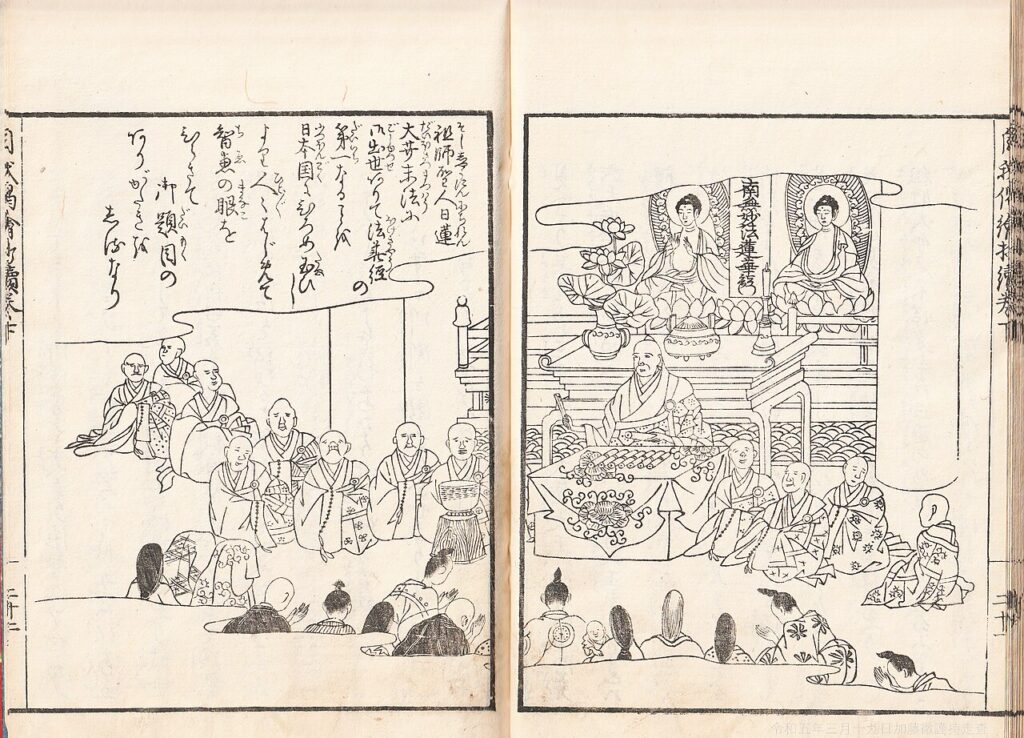
“Nichiren’s Later Years and His Disciples: ‘Jigage Esho Zokuhen,’ 1818”
日蓮の影響と後世への遺産
日蓮は、日蓮宗の宗祖として知られ、妙法蓮華経を中心とした教えを広めた僧侶である。
彼の生涯は、多くの困難と挑戦に満ちていた。
身延入山では、日蓮の最晩年における深い修行と教義の集大成が見られる。
ここで彼は、『開目抄』や『観心本尊抄』などの重要な著作を残し、後世への道を示した。
文永の役と弘安の役の期間には、日蓮は時代の転換点に立ち、社会の不安定さを見据えて『立正安国論』を著し、国の指導者たちへ警鐘を鳴らした。
この論文は、国主諫暁の精神を体現しており、その思想は現代にも大きな影響を与えている。
朝廷への諫暁では、日蓮は朝廷や国の指導者たちに対して、社会の秩序と安定を保つための重要な提言を行った。
彼のこの行動は、社会への深い影響力を示すものであり、念仏批判や「専修題目」の提唱を通じて、宗教的な枠組みを超えた社会改革の必要性を訴えた。
日蓮の入滅後、彼の遺産は多大なものとなり、『一念三千理事』や『十如是事』などの教義は、日蓮宗の中心的な教えとして受け継がれている。
また、彼の教えは「南無妙法蓮華経」という題目を通じて、多くの人々に希望と勇気を与え続けている。
日蓮の生涯と教えは、現代社会においてもその価値を失っていない。
彼の思想は、個人の精神性の向上だけでなく、社会全体の平和と安定を求める上で、重要な指針となっている。
そのため、日蓮の影響と後世への遺産は、今後も多くの人々にとって大きな意味を持ち続けることだろう。
身延入山と日蓮の最晩年
日蓮大聖人は、法華宗(日蓮宗)の宗祖として、日本仏教史において重要な位置を占めています。
その生涯の中で、特に注目すべきは身延入山とその最晩年の活動です。
日蓮は、1271年に龍の口の法難に遭遇し、その後、佐渡に流罪となりました。
この時期は、彼にとって試練の連続であったにもかかわらず、法華経の普及と『立正安国論』を通じて社会の安定を訴え続けました。
佐渡から帰還した後の1274年、日蓮は身延山に入山し、清澄寺を開山しました。
身延山での生活は、彼の教えを集約し、後世に伝えるための重要な時期となります。
身延山では、『開目抄』や『報恩抄』など、多くの重要な著作を残しています。
これらの著作は、日蓮の思想を深く理解する上で欠かせない文献です。
日蓮の教えは、妙法蓮華経(法華経)に基づき、「南無妙法蓮華経」の題目を唱えることで、末法の世においても人々が救われると説いています。
彼は、念仏や専修題目の実践を通じて、人々が本来持つ仏性を開花させることができると強調しました。
日蓮のこの教えは、後の日蓮宗の基礎となり、多くの人々に受け入れられました。
文永の役と弘安の役の時期には、日本は外からの脅威に直面していました。
この時代の転換点において、日蓮は朝廷への諫暁を行い、国の安泰を願いました。
彼の社会への影響は、ただ宗教的な教えにとどまらず、政治的な問題にも積極的に関わろうとした点にも見られます。
日蓮の入滅は、1282年に身延山で起こりました。
しかし、彼の遺産は現代にも大きな影響を与えています。
日蓮の教えは、個人の精神的な成長だけでなく、社会全体の平和と安定を目指すものであることが、今日でも多くの人々に受け入れられている理由です。
日蓮大聖人の最晩年の活動は、彼の生涯を通じて築き上げた教えの集大成であり、後世への貴重な遺産と言えるでしょう。
文永の役と弘安の役:時代の転換点としての日蓮
日蓮は、日蓮宗(法華宗)の宗祖として広く知られる存在であり、彼の教えは多くの人々に影響を与え続けています。
その中でも特に重要なのが、文永の役と弘安の役の時期における彼の活動です。
これらの出来事は、日本の歴史上、外国からの侵攻を受けた重要な局面であり、日蓮の思想が社会に与えた影響の大きさを物語っています。
身延入山に隠遁した日蓮の最晩年は、彼の教えを深め、後世に伝えるための重要な時期でした。
『立正安国論』を始めとする彼の著作は、国難の時代にあって、人々が内省し、精神的な支柱を見出すための道標となりました。
日蓮は、妙法蓮華経を中心に、末法の思想を展開し、人々に南無妙法蓮華経の専修を説きました。
文永の役と弘安の役の間において、日蓮は朝廷への諫暁を行い、社会に対しても積極的に影響を及ぼそうとしました。
彼は、国の危機に際して、国主や政治的指導者たちに対して警鐘を鳴らし、また、一般の人々に対しても、信仰を通じて精神的な充実を促すことで、社会の安定と国家の守護を目指しました。
日蓮の入滅後も、彼の遺産は多大な影響を与え続けています。
日蓮が生涯を通じて示した、信仰の力を通じた社会貢献の精神は、現代においても多くの人々にとって重要な指針となっています。
『開目抄』や『観心本尊抄』などの著作は、彼の思想を深く理解する上で欠かせない資料であり、日蓮の教えを学ぶ人々にとっての宝物です。
文永の役と弘安の役を通じて見る日蓮の活動は、時代の転換点における彼の思想の深さと、社会への影響の大きさを示しています。
この時期における日蓮の役割を理解することは、日本の歴史、特に宗教的な観点から見た国難への対応の理解を深める上で非常に有意義です。
日蓮の遺産は、現代においても多くの人々にとって精神的な支えとなり、彼の教えが持つ普遍的な価値を今一度見直す機会を提供しています。
朝廷への諫暁と社会への影響
日蓮大聖人は、日蓮宗(法華宗)の宗祖として知られ、その教えは多くの人々に影響を与え続けています。
身延入山に隠遁した最晩年にも、彼の精神は不変であり、『立正安国論』を通じて国主への諫暁を行い、社会に大きな影響を及ぼしました。
文永の役と弘安の役は、日蓮の生涯における重要な時代の転換点であり、彼の思想が如何に時代を超えて受け継がれているかを示しています。
日蓮の朝廷への諫暁は、単に政治的な行為にとどまらず、社会全体への深い影響を及ぼしました。
彼は、妙法蓮華経(法華経)を根幹に、末法の世を救うための「専修題目」を提唱し、念仏などの既存の宗教実践を批判しました。
このような彼の行動は、松葉ヶ谷の法難や龍の口の法難など、数々の迫害を受ける原因となりましたが、その信念は多くの人々に受け入れられ、日蓮宗としての基盤を築きました。
日蓮の入滅後も、彼の遺産は現代に至るまで大きな意義を持ち続けています。
『開目抄』や『観心本尊抄』などの著作は、彼の深い洞察と仏法への理解を今に伝えており、『守護国家論』や『災難対治抄』は、社会の安定と国家の繁栄への道を示しています。
日蓮の思想は、個人の精神性だけでなく、社会全体への貢献という形で、後世に大きな遺産を残しました。
彼の生涯と教えは、現代社会においても多くの人々にとって重要な指針となっており、日蓮大聖人の精神は、時代を超えて多くの人々の心に響き続けています。
そのため、日蓮が朝廷へ行った諫暁と、それが社会に与えた影響は、歴史を学ぶ上で非常に重要な要素と言えるでしょう。
日蓮の入滅とその遺産の現代への意義
日蓮大聖人は、日蓮宗(法華宗)の宗祖として知られ、その教えは現代にも大きな影響を与えています。
身延入山から始まる彼の生涯は、多くの試練と成果に満ちていました。
特に『立正安国論』を提出したことは、国主諫暁としての彼の立場を明確にし、佐渡流罪や清澄寺での活動を通じて、妙法蓮華経(法華経)の普及に尽力しました。
日蓮の教えは「専修題目」として、南無妙法蓮華経を中心に展開され、念仏批判や末法の理念を通して、当時の宗教観に革新をもたらしました。
松葉ヶ谷の法難、伊豆流罪、小松原の法難、そして龍の口の法難は、彼が直面した重要な試練であり、その教えの強固さを示す出来事でした。
『一代聖教大意』や『一念三千理事』などの著作は、日蓮の思想の深さを物語っています。
『守護国家論』や『災難対治抄』では、社会的な問題に対する彼の見解が示され、『開目抄』や『観心本尊抄』では、宗教的実践の核心が説かれました。
日蓮の最晩年を過ごした身延山は、彼の教えを今に伝える重要な場所となっています。
文永の役や弘安の役の時代背景の中で、日蓮は朝廷への諫暁を行い、社会への影響を与え続けました。
彼の入滅後も、『撰時抄』や『報恩抄』などの著作は、後世に大きな遺産として残されました。
日蓮の教えとその遺産は、現代社会においてもその意義を失っていません。
彼の思想は、個人の精神的成長はもちろんのこと、社会の平和と安定に寄与する普遍的なメッセージを持っています。
日蓮大聖人の生涯と教えは、今日に生きる私たちにとって、深く考え、行動するための重要な指針となるのです。
The Influence of Nichiren and His Legacy for Future Generations
Nichiren is renowned as the founder of Nichiren Buddhism, spreading teachings centered around the Lotus Sutra.
His life was fraught with numerous challenges and adversities.
At Mount Minobu, his later years epitomized deep spiritual practice and the culmination of his teachings.
It was here that he authored significant works like the “Kaimoku Sho” and “Kanjin Honzon Sho,” guiding future generations.
During the periods of the Genkō and Kōan wars, Nichiren stood at a societal crossroads and penned the “Risshō Ankoku Ron,” sounding alarms to the nation’s leaders.
This treatise embodied the spirit of advising the sovereign for the nation’s well-being and continues to exert profound influence today.
In his admonitions to the court, Nichiren provided crucial counsel to the imperial court and national leaders for maintaining social order and stability.
His actions showcased profound societal influence, advocating for necessary societal reforms beyond religious boundaries through critiques of Pure Land Buddhism and advocating the exclusive recitation of the “Nam Myoho Renge Kyo” mantra.
After Nichiren’s passing, his legacy became substantial, with teachings like the “Ichinen Sanzen” and “Jūnyoze” doctrines continuing as central tenets of Nichiren Buddhism.
Through the mantra “Nam Myoho Renge Kyo,” Nichiren instilled hope and courage in many, even amidst the age of Mappō (the Latter Day of the Law).
Nichiren’s life and teachings retain their value in contemporary society.
His philosophy serves not only to elevate individual spiritual growth but also as a vital guideline for seeking peace and stability across society.
Thus, Nichiren’s influence and legacy for future generations continue to hold profound significance for many people.
Mount Minobu and Nichiren’s Later Years
Nichiren Daishonin is a pivotal figure in Japanese Buddhist history, revered as the founder of Nichiren Buddhism.
Of particular note is his secluded life at Mount Minobu and his activities in his later years.
In 1271, Nichiren faced severe persecution at Tatsunokuchi and was subsequently exiled to Sado Island.
Despite these trials, he continued his efforts to spread the Lotus Sutra’s teachings and advocated for societal stability through works like the “Risshō Ankoku Ron.”
Upon returning from Sado in 1274, Nichiren entered Mount Minobu and founded the Kuonji temple.
His time at Mount Minobu was crucial for consolidating his teachings and preparing them for future generations.
During this period, he left behind significant works such as the “Kaimoku Sho” and “Hōon Sho.”
These writings are indispensable for understanding Nichiren’s philosophy deeply.
Based on the Lotus Sutra, Nichiren’s teachings emphasized salvation in the Mappō era through exclusive devotion to the mantra “Nam Myoho Renge Kyo.”
He emphasized that through practices like reciting the Nembutsu or the “Namu Amida Butsu” mantra, people could bring out their inherent Buddha nature.
His teachings laid the foundation for Nichiren Buddhism and garnered acceptance from many.
During the Genkō and Kōan wars, Japan faced external threats.
At this turning point in history, Nichiren advised the imperial court and actively sought to influence political issues.
His actions included admonishing national leaders during times of crisis and encouraging societal stability through faith.
Nichiren passed away at Mount Minobu in 1282.
However, his legacy continues to wield significant influence to this day.
Nichiren’s teachings remain relevant not only for individual spiritual growth but also as essential principles for seeking peace and stability across society.
Therefore, Nichiren Daishonin’s activities in his later years represent a culmination of his life’s teachings and a precious legacy for future generations.
Genkō and Kōan Wars: Nichiren as a Turning Point in History
Nichiren is widely recognized as the founder of Nichiren Buddhism (Hokke-shū), and his teachings continue to influence many people.
Of particular importance are his activities during the Genkō and Kōan wars.
These events mark critical junctures in Japanese history, where Nichiren’s ideologies had a profound impact on society.
His later years spent in seclusion at Mount Minobu were a pivotal period for deepening his teachings and transmitting them to future generations.
Through works like the “Risshō Ankoku Ron,” Nichiren provided counsel to the sovereign, advocating for societal introspection and serving as a spiritual pillar during national crises.
Nichiren expanded on the Lotus Sutra’s teachings, promoting the concept of Mappō and emphasizing the practice of “Nam Myoho Renge Kyo.”
Between the Genkō and Kōan wars, Nichiren advised the imperial court and continued to exert a significant influence on society.
His calls to the court were not merely political maneuvers but carried profound implications for society at large.
During times of national crisis, he warned feudal lords and political leaders, urging them to protect the nation and foster societal stability.
Although Nichiren passed away in 1282 at Mount Minobu, his legacy remains impactful to this day.
Works like the “Senji Sho” and “Hōon Sho” are treasured resources that convey his deep insights into Buddhist teachings.
Nichiren’s teachings not only promote individual spiritual growth but also advocate for contributing to society’s peace and stability.
His life and teachings provide important guidance for contemporary individuals to contemplate and act upon.
Understanding Nichiren’s role during the Genkō and Kōan wars is crucial for grasping Japan’s history, especially concerning responses to national crises from a religious perspective.
Nichiren’s legacy continues to provide spiritual support to many people in modern society, offering an opportunity to reassess the universal values inherent in his teachings.
Admonishing the Imperial Court and Impact on Society
Nichiren Daishonin is widely known as the founder of Nichiren Buddhism (Hokke-shū), and his teachings continue to influence many people.
During his later years at Mount Minobu, where he secluded himself, Nichiren’s unwavering spirit persisted.
Through works like the “Risshō Ankoku Ron,” he advised the sovereign, impacting society significantly.
The Genkō and Kōan wars marked critical turning points in history, during which Nichiren’s activities were crucial.
His life at Mount Minobu, beginning in seclusion, was a significant period for deepening his teachings and transmitting them to future generations.
Submitting the “Risshō Ankoku Ron” affirmed his position as a counselor to the sovereign, even during his exile on Sado Island and activities at Kuonji temple.
Nichiren emphasized the practice of “Nam Myoho Renge Kyo,” based on the Lotus Sutra, addressing the essence of the latter days.
The adversity he faced at Matsubagayatsu, Izu exile, Komatsubara, and Tatsunokuchi highlights the robustness of his teachings.
Works like “Ichidai Shōkyō Daii” and “Ichinen Sanzen” underscore his profound insights.
His “Shugo Kokka Ron” and “Sainan Taishi Shō” address societal issues, while “Kaimoku Sho” and “Kanshin Honzon Sho” discuss religious practices.
His final years at Mount Minobu were significant, transmitting his teachings.
During the Genkō and Kōan wars, Nichiren admonished the imperial court, continuing his societal impact.
His entries provide vital elements for understanding historical reactions to religious crises.
The legacy continues, with his “Senji Sho” and “Hōon Sho” treasure troves.
Nichiren’s teachings promote spiritual and social security today.
Nichiren Daishonin’s life and teachings offer critical advice.
Nichiren’s Legacy and Relevance to Modern Times
Nichiren Daishonin, known for founding Nichiren Buddhism (Hokke-shū), continues to influence the religion, and his teachings are still significant.
During his secluded life on Mount Minobu, Nichiren faced adversity and established himself as a significant figure in Japanese Buddhist history.
Of particular importance was the time he spent secluded and his activities in the later years.
During 1271, Nichiren faced persecution at the Tatsunokuchi, leading to the subsequent exile of Sado Island.
Despite these challenges, he continued to advocate for the spread of the Lotus Sutra and social stability through his works like “Risshō Ankoku Ron.”
Upon returning from Sado in 1274, Nichiren entered Mount Minobu and opened the Kuonji temple.
His life on Mount Minobu was a pivotal moment in consolidating and passing on his teachings to future generations.
Works such as the “Kaimoku Sho” and “Hōon Sho” are essential texts for understanding Nichiren’s philosophy.
Nichiren’s teachings were based on the Lotus Sutra, emphasizing the exclusive recitation of “Nam Myoho Renge Kyo” to save people in the Mappō era.
He asserted that by practicing the “Nembutsu” or the “Namu Amida Butsu” mantra, individuals could reveal their inherent Buddha nature.
His teachings formed the foundation of Nichiren Buddhism and gained widespread acceptance.
During the Genkō and Kōan wars, Japan faced external threats.
During this period, Nichiren advised the imperial court, actively influencing political matters.
He provided essential advice to feudal lords and political leaders during national crises, aiming to safeguard the nation and promote societal stability.
Nichiren passed away at Mount Minobu in 1282.
However, his legacy remains significant to this day.
Works such as the “Senji Sho” and “Hōon Sho” are preserved as substantial legacies.
Nichiren’s teachings are not only about personal spiritual growth but also provide essential principles for seeking peace and stability across society.
Therefore, Nichiren Daishonin’s later-life activities represent

The Taho Pagoda Erected at the Site of Nichiren’s Cremation (Ikegami Honmonji)
日蓮と法華経の普遍的メッセージ
日蓮と法華経は、時代を超えて多くの人々に影響を与え続けています。
日蓮大聖人は、妙法蓮華経(法華経)の教えを広め、多くの著作を通じてその普遍的メッセージを伝えました。
特に『唱法華題目抄』や『守護国家論』では、国家の安泰と個人の幸福を願う心が強調されています。
日蓮は、国主諫暁や佐渡流罪など逆境に立ち向かいながらも、末法の世において法華経の教えがいかに重要であるかを説きました。
逆境を乗り越える智慧については、『災難対治抄』や『種種御振舞御書』が光を投げかけます。
これらの文献では、困難に直面した際の心構えや対応策が示されており、読む者に深い洞察を提供します。
日蓮自身が伊豆流罪や松葉ヶ谷の法難など、数々の試練を経験したことが、これらの教えに生きた実践の重みを加えています。
内なる仏性を発見する旅には、『観心本尊抄』と『顕仏未来記』が案内役となります。
日蓮は、すべての人が本来持っている仏性を見出し、それを育てることの大切さを説きました。
彼の教えは、自己と向き合い、内面の光を見つけることの重要性を強調しています。
また、感謝と恩返しの精神は、『撰時抄』と『報恩抄』によって深く掘り下げられています。
日蓮は、人として生きる上で恩恵に対する感謝の心を持ち、それを行動に移すことの大切さを説いています。
彼の教えは、人間関係や社会全体における調和と平和への道を示しています。
日蓮と法華経の普遍的メッセージは、現代社会においても多くの示唆を与えます。
国家や個人の安泰、逆境の乗り越え方、内なる仏性の発見、感謝と恩返しの精神は、今日私たちが直面する問題に対して、有効な指針を提供してくれるでしょう。
日蓮大聖人の教えを学び、実践することで、より豊かで意味のある人生を送ることができるはずです。
『唱法華題目抄』と『守護国家論』:国家と個人の安泰への道
日蓮大聖人は、法華経の教えを基に、国家と個人の安泰を願い、数々の著作を残しました。
『唱法華題目抄』と『守護国家論』はその中でも特に重要なテキストです。
これらは、社会の不安定さや人々の苦悩への対処法を説いたものであり、日蓮の思想の核心をなす部分です。
『唱法華題目抄』では、南無妙法蓮華経の題目を唱えることの重要性を強調しています。
この実践を通じて、個人は内なる平和を見出し、さらには社会全体の安定に貢献できると説かれています。
日蓮は、この題目の唱えることが末法の時代における最良の修行法であると位置づけました。
一方、『守護国家論』では、国家の安泰を守るための方策が語られています。
日蓮は、国家の危機は人々の信仰の乏しさから生じると考え、正しい信仰に基づく行動が国家の平和をもたらすと主張しました。
この著作では、国主や政府への諫暁も含まれており、社会の指導者たちも正しい信仰に基づいて行動することの重要性を説いています。
日蓮の教えは、個人の内面の変革が社会全体の安定につながるという考えに基づいています。
彼の著作は、不安定な時代を生きる私たちにとっても、大きな示唆を与えてくれます。
日蓮宗の宗祖として、彼の思想は今なお多くの人々に影響を及ぼし続けています。
『災難対治抄』と『種種御振舞御書』は、逆境を乗り越える智慧について語っています。
これらのテキストは、困難に直面したときにどのように対処すべきか、具体的な指南を提供しています。
日蓮は、困難は乗り越えるべき試練であり、信仰を深める機会だと捉えていました。
『観心本尊抄」』と『顕仏未来記』では、人間一人ひとりが内に持つ仏性の発見に焦点を当てています。
日蓮は、すべての人が仏性を内に秘めており、正しい修行を通じてその仏性を顕現できると説きました。
これらの教えは、自己の内面を深く理解し、真の自己実現を目指すための道しるべとなります。
最後に、『撰時抄』と『報恩抄』は、感謝と恩返しの精神について述べています。
日蓮は、人として生きる上で、他者への感謝の心と恩返しの行動が不可欠であると強調しました。
これらのテキストを通じて、日蓮は人間関係の本質と社会における個人の役割について深い洞察を与えています。
日蓮大聖人の教えは、個人の心の変革が社会全体の安定と繁栄につながるという強力なメッセージを私たちに伝えています。
その普遍的なメッセージは、現代社会にも大きな意味を持ち、私たち一人ひとりが内面を見つめ、より良い社会の実現に向けて努力することの重要性を教えてくれます。
The Universal Message of Nichiren and the Lotus Sutra
Nichiren and the Lotus Sutra continue to influence countless individuals across generations.
Nichiren Daishonin propagated the teachings of the Lotus Sutra, conveying its universal message through numerous writings.
Particularly in works like the “Ode to the Gohonzon” and “On Establishing the Correct Teaching for the Peace of the Land,” the emphasis is on seeking the stability of nations and the happiness of individuals.
Nichiren faced adversity such as exile to Sado and persecution in Matsubagayatsu, yet he preached the importance of the Lotus Sutra’s teachings in the age of degeneration.
Regarding wisdom in overcoming adversity, texts like the “Remedy for Disasters” and “Various Actions for the Good of All” shed light.
These writings offer insights into attitudes and strategies when facing difficulties, providing deep insights for readers.
Nichiren’s personal experiences, including his exile and legal challenges, imbue these teachings with practical wisdom.
Guides like the “Observing the Mind” and “Predictions of Revealed Buddhas” serve as guides on discovering inherent Buddhahood.
Nichiren taught that everyone possesses inherent Buddhahood and emphasized the importance of nurturing it.
His teachings stress the significance of confronting oneself and discovering inner enlightenment.
Moreover, the spirit of gratitude and reciprocation is deeply explored in works such as the “Selection of the Time” and “Reciprocation of Favor.”
Nichiren emphasized gratitude toward blessings in life and the importance of translating it into action.
His teachings indicate paths to harmony and peace within human relations and society.
The universal message of Nichiren and the Lotus Sutra provides much insight even in contemporary society.
Paths to national and personal security, overcoming adversity, discovering inner Buddhahood, and embodying gratitude and reciprocation are effective guides for addressing today’s challenges.
By learning and practicing Nichiren Daishonin’s teachings, one can lead a richer and more meaningful life.
“Ode to the Gohonzon” and “On Establishing the Correct Teaching for the Peace of the Land”: Paths to National and Personal Security
Based on the Lotus Sutra’s teachings, Nichiren Daishonin sought the security of nations and individuals, leaving behind numerous writings.
“Ode to the Gohonzon” and “On Establishing the Correct Teaching for the Peace of the Land” are particularly significant texts.
They address societal instability and human suffering, constituting the core of Nichiren’s philosophy.
“Ode to the Gohonzon” underscores the importance of chanting Nam-myoho-renge-kyo.
Through this practice, individuals find inner peace and contribute to societal stability.
Nichiren positioned this practice as the best form of training for the degenerate age.
Conversely, “On Establishing the Correct Teaching for the Peace of the Land” discusses strategies to safeguard national security.
Nichiren believed that national crises stemmed from people’s lack of faith and asserted that actions based on correct faith could bring peace to the nation.
This work includes admonitions to rulers and governments, stressing the importance of leaders acting based on correct faith.
Nichiren’s teachings are based on the belief that individual inner transformation leads to societal stability.
His writings offer profound insights for those of us living in turbulent times.
As the founder of Nichiren Buddhism, his thoughts continue to influence many people today.
“Remedy for Disasters” and “Various Actions for the Good of All” discuss wisdom in overcoming adversity.
These texts provide concrete guidance on how to deal with difficulties when they arise.
Nichiren viewed challenges as opportunities to deepen faith and overcome adversity.
“Observing the Mind” and “Predictions of Revealed Buddhas” focus on discovering the inherent Buddhahood within each individual.
Nichiren taught that everyone harbors Buddhahood within and can manifest it through correct practice.
These teachings serve as signposts for understanding one’s inner self deeply and striving for true self-realization.
Finally, “Selection of the Time” and “Reciprocation of Favor” address the spirit of gratitude and reciprocation.
Nichiren emphasized that gratitude toward others and actions of reciprocation are essential for living as human beings.
Through these texts, Nichiren provides deep insights into the essence of human relationships and the role of individuals in society.
Nichiren Daishonin’s teachings convey a powerful message that individual inner change leads to societal stability and prosperity.
Their universal message holds great significance in contemporary society, teaching us the importance of introspection and efforts toward realizing a better society for all.
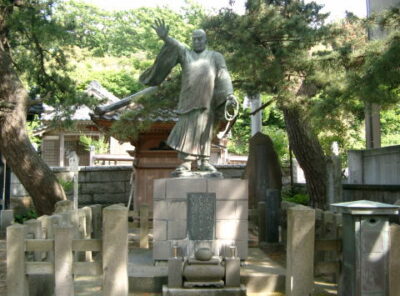
The bronze statue of Nichiren Shonin’s Lion’s Roar stands at a site where he stayed before heading to Sado Island (Hofuku-ji Temple, Teradomari, Nagaoka City, Niigata Prefecture).
『災難対治抄』と『種種御振舞御書』:逆境を乗り越える智慧
日蓮大聖人は、法華経の教えを基に、人々の苦難を乗り越えるための指針を示した偉大な僧侶です。
彼の著作『災難対治抄』と『種種御振舞御書』は、逆境を乗り越えるための智慧が詰まっています。
日蓮は、妙法蓮華経(法華経)に基づき、人生の苦難に直面した際にどのように対処すべきかを説いています。
『災難対治抄』では、日蓮自身が経験した様々な迫害や試練、特に松葉ヶ谷の法難や龍の口の法難など、厳しい逆境を乗り越える中で得た教訓を伝えています。
彼は、逆境は自身の信仰を試す機会であり、南無妙法蓮華経の題目を唱えることで、内なる強さと智慧を引き出すことができると説いています。
一方、『種種御振舞御書』では、日蓮が佐渡流罪中に信者たちに宛てた手紙の集成であり、苦難の中でも正しい心持ちで行動することの重要性を説いています。
日蓮は、末法の時代において、妙法蓮華経の教えを守り、専修題目を唱えることで、国家や個人の安泰を実現できると強調しています。
これらの著作を通して、日蓮は逆境に立ち向かう勇気と、困難を乗り越えるための智慧を提供しています。
彼の教えは、『立正安国論』や『守護国家論』など他の著作にも共通するテーマであり、国主諫暁や朝廷への諫暁といった行動にも表れています。
日蓮の普遍的メッセージは、今日においても多くの人々に影響を与えています。
『災難対治抄』と『種種御振舞御書』から学ぶことは、現代社会で直面する様々な困難に対しても、内なる力を信じ、前向きに取り組むことの大切さを教えてくれます。
日蓮宗の宗祖として、彼の教えは、法華経の普遍的な真理を現代に伝え、人々が逆境を乗り越えるための指針となっています。
『観心本尊抄』と『顕仏未来記』:内なる仏性の発見
日蓮大聖人は、法華経の教えを日本に広めたことで知られている。
その中でも『観心本尊抄』と『顕仏未来記』は、内なる仏性を見出すという深いメッセージを伝えています。
日蓮は、身延山に入山し、多くの法難に直面しながらも、その信念を貫きました。
特に、『観心本尊抄』では、自己の内面を深く観察し、本来持っている仏性に気づくことの重要性を説いています。
一方、『顕仏未来記』では、未来における仏教の普及と、それによってもたらされる平和な世界の実現を予言しているのです。
日蓮宗は、日蓮大聖人の教えに基づいて成立しました。
その核心にあるのは、「南無妙法蓮華経」という題目の唱えることによって、人々が自らの仏性を発見し、苦難を乗り越える力を得ることができるという信念です。
日蓮大聖人は、『立正安国論』を通じて、国家の安泰も個人の幸福も、法華経の教えによって達成されると訴えました。
さらに、日蓮大聖人は、念仏や専修題目の実践を批判し、法華経の唱題を通じて、人々が直面するさまざまな災難に対処する方法を示しました。
『災難対治抄』や『種種御振舞御書』では、逆境を乗り越える智慧について詳述しており、多くの信者にとって指針となっています。
日蓮大聖人の教えは、単に宗教的な信仰に留まらず、人々が日々の生活の中で直面する困難に対しても、具体的な解決策を提供しているのです。
『撰時抄』や『報恩抄』を通じて、感謝と恩返しの精神を強調し、社会に対する貢献の大切さも説いています。
これらの教えは、現代社会においても非常に有効であり、多くの人々にとって心の支えとなっています。
日蓮大聖人の著作は、時代を超えて人々に影響を与え続けています。
『観心本尊抄』と『顕仏未来記』をはじめとするこれらのテキストは、内なる仏性を発見し、逆境に打ち勝つための智慧を探求する旅において、貴重な指南書となるでしょう。
“The Wisdom to Overcome Adversity: ‘Disaster Recovery Treatise’ and ‘Various Acts of Conduct'”
Nichiren Daishonin, a great monk who based his teachings on the Lotus Sutra, provided guidance on how to overcome people’s hardships.
His works, ‘Disaster Recovery Treatise’ and ‘Various Acts of Conduct’, are filled with wisdom on overcoming adversity.
Nichiren, grounded in the Lotus Sutra, discusses how to confront life’s hardships.
In ‘Disaster Recovery Treatise’, he shares lessons learned from severe adversity such as persecution and trials in places like Matsubagayatsu and Ryo-no-guchi during his life.
He emphasizes that adversity tests one’s faith and chanting Nam-myoho-renge-kyo can bring forth inner strength and wisdom.
In contrast, ‘Various Acts of Conduct’ compiles letters Nichiren wrote to his followers during his exile in Sado, stressing the importance of maintaining the right mindset amidst difficulties.
Nichiren highlights that by upholding the teachings of the Lotus Sutra and chanting Nam-myoho-renge-kyo in this age of Mappo, both national and personal security can be achieved.
Through these works, Nichiren offers courage to face adversity and wisdom to overcome challenges.
His teachings, echoed in other works like ‘On Establishing the Correct Teaching for the Peace of the Land’ and ‘The Opening of the Eyes’, continue to influence many today.
“Discovering the Inner Buddha Nature: ‘On Attaining Buddhahood in This Lifetime’ and ‘The Opening of the Eyes'”
Nichiren Daishonin is renowned for spreading the teachings of the Lotus Sutra in Japan.
Among these, ‘On Attaining Buddhahood in This Lifetime’ and ‘The Opening of the Eyes’ convey a profound message of discovering one’s inner Buddha nature.
Nichiren entered Mount Minobu and faced numerous persecutions while remaining steadfast in his beliefs.
Especially in ‘On Attaining Buddhahood in This Lifetime’, he emphasizes the importance of introspection to recognize one’s inherent Buddha nature.
Conversely, ‘The Opening of the Eyes’ prophesies the future spread of Buddhism and the realization of a peaceful world.
Nichiren Buddhism was established based on Nichiren Daishonin’s teachings.
At its core is the belief that chanting “Nam-myoho-renge-kyo” allows people to discover their Buddha nature and gain the strength to overcome hardships.
Through ‘On Establishing the Correct Teaching for the Peace of the Land’, Nichiren asserts that both national security and personal happiness can be achieved through the teachings of the Lotus Sutra.
Furthermore, Nichiren critiques practices like Nembutsu and emphasizes facing various calamities through chanting the Lotus Sutra.
‘Disaster Recovery Treatise’ and ‘Various Acts of Conduct’ detail wisdom for overcoming adversity, serving as guiding principles for many believers.
Nichiren Daishonin’s teachings not only foster religious faith but also offer concrete solutions to everyday challenges faced by people.
Through ‘Selections of the Time’ and ‘The Reciprocal Relations of Gratitude’, he stresses the importance of gratitude and repaying kindness, highlighting the significance of contributing to society.
These teachings remain highly effective in modern society, providing spiritual support to many.
Nichiren Daishonin’s writings continue to influence people across generations.
Works like ‘On Attaining Buddhahood in This Lifetime’ and ‘The Opening of the Eyes’ will undoubtedly serve as invaluable guides on the journey to discover inner Buddha nature and wisdom to overcome adversity.
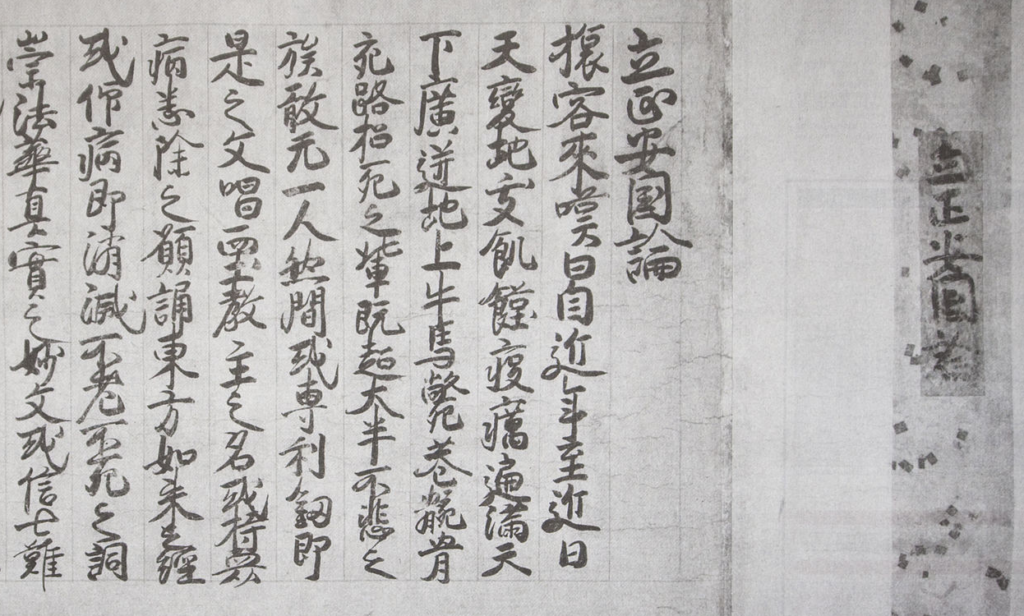
“Treatise on Establishing the Correct Teaching for the Peace of the Land” (Opening Section, Authored and Penned by Nichiren, Hokekyo-ji Temple Collection, National Treasure)
『撰時抄』と『報恩抄』:感謝と恩返しの精神
日蓮大聖人は、日蓮宗の宗祖であり、その教えは妙法蓮華経に基づいています。
彼の著作には、国家や個人の安泰を願い、逆境を乗り越える智慧や内なる仏性の発見についての深い洞察が含まれています。
特に『撰時抄』と『報恩抄』は、感謝と恩返しの精神に焦点を当てた重要なテキストです。
日蓮は、その生涯を通じて、多くの困難に直面しました。
伊豆流罪や佐渡流罪など、彼が経験した法難は、彼の信念と妙法蓮華経への深い帰依を試すものでした。
しかし、これらの試練を乗り越えることで、日蓮はさらに強固な信仰心を築き上げていきました。
『唱法華題目抄』や『守護国家論』では、国家の平和と安定を願う日蓮の思いが表現されています。
一方で、『災難対治抄』や『種種御振舞御書』では、逆境をどのように乗り越えるかという具体的な指南が記されており、日蓮の教えの実践的な側面を垣間見ることができます。
『観心本尊抄』や『顕仏未来記』では、個人が内なる仏性を発見し、その力を引き出す方法について説明されています。
これらのテキストは、自己実現と精神的成長を目指す人々にとって貴重な資料となっています。
そして、『撰時抄』と『報恩抄』は、日蓮の教えの中でも特に人間関係における感謝と恩返しの重要性を説くテキストです。
日蓮は、私たちが他者から受けた恩恵に対して常に感謝の心を持ち、恩返しをすることで、より良い社会を築くことができると説いています。
日蓮の思想は、単に宗教的な教義に留まらず、現代社会においても私たちの生活や心のあり方に深く関わる普遍的なメッセージを含んでいます。
『撰時抄』と『報恩抄』を通じて、感謝と恩返しの精神を学び、実践することは、今日の忙しい世の中で心の平和を保つ一助となるでしょう。
“Selections on Time and Gratitude” and “On Repaying Debts of Gratitude”: Spirit of Appreciation and Reciprocation
Nichiren Daishonin, the founder of Nichiren Buddhism, based his teachings on the Lotus Sutra.
His writings contain profound insights into wishing for the peace and prosperity of nations and individuals, and discovering wisdom to overcome adversity and uncover one’s inner Buddha nature.
In particular, “Selections on Time and Gratitude” and “On Repaying Debts of Gratitude” focus on the spirit of appreciation and reciprocation, making them crucial texts.
Throughout his life, Nichiren faced numerous difficulties, such as exile to Izu and Sado, which tested his faith and deep commitment to the Lotus Sutra.
Yet, through overcoming these trials, Nichiren built an even stronger sense of faith.
In works like “On Establishing the Correct Teaching for the Peace of the Land” and “Selections on Time and Gratitude,” Nichiren expresses his aspirations for peace and stability in the nation.
Conversely, “Selections on Confronting Calamity” and “On Various Actions” provide concrete guidance on how to overcome adversity, offering practical insights into Nichiren’s teachings.
In “On the Object of Devotion for Observing the Mind” and “The Object of Devotion for Observing the Buddha,” methods for individuals to discover their inner Buddha nature and harness that power are explained.
These texts serve as invaluable resources for those pursuing self-realization and spiritual growth.
“Selections on Time and Gratitude” and “On Repaying Debts of Gratitude” specifically emphasize the importance of gratitude and reciprocation in relationships within Nichiren’s teachings.
Nichiren teaches that maintaining a heart of gratitude and repaying the kindness received from others can help build a better society.
Nichiren’s philosophy contains universal messages that deeply influence not only religious doctrines but also our daily lives and inner selves in contemporary society.
Learning and practicing the spirit of gratitude and reciprocation through “Selections on Time and Gratitude” and “On Repaying Debts of Gratitude” can contribute to maintaining inner peace in today’s hectic world.
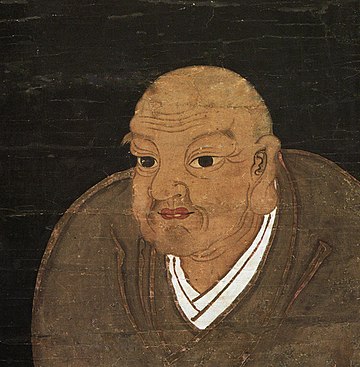

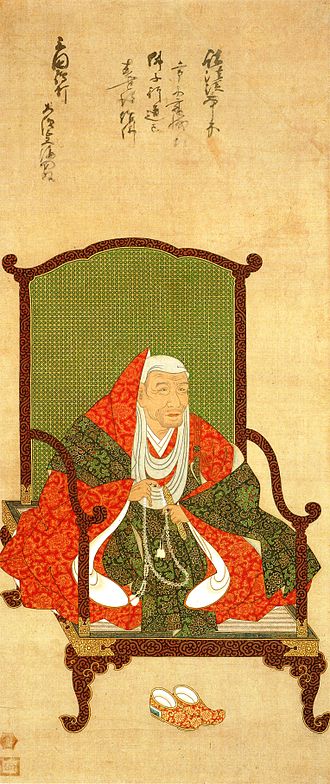
コメント